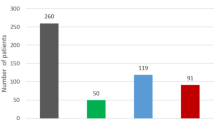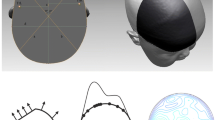Abstract
Deformational plagiocephaly (DP) in newborns and very young children is a common problem in daily practice. The intrarater and interrater reliability of plagiocephalometry (PCM), a new, non-invasive, inexpensive instrument to assess and quantify the asymmetry of the skull, is evaluated at the outpatient Department of Physical Therapy of the Bernhoven Hospital at Veghel, The Netherlands. Using a thermoplastic material to mould the outline of the infant’s skull, a reproduction of the skull shape is performed on paper, allowing for accurate cephalometric measurements. Fifty children (aged 0–24 months), with or without positional preference of the head, and with or without DP, were measured three times by two separate, experienced pediatric physical therapists. Intraclass correlation coefficients (ICC) regarding the measurements of the drawn lines were all above 0.92 (intrarater reliability) and 0.90 (interrater reliability). The ICCs of the plagiocephaly indicators ear deviation (ED), antero-sinistra−antero-dextra (ASAD), postero-dextra−postero-sinistra (PDPS) and oblique diameter difference (ODD) were 0.88, 0.57, 0.92 and 0.96, respectively, for the intrarater reliability and 0.90, 0.65, 0.94 and 0.96, respectively, for the interrater reliability. The ICCs of the two indices oblique diameter difference index (ODDI) and cranial proportional index (CPI) were 0.97 and 0.96, respectively, for the intrarater reliability and 0.95 and 0.92, respectively, for the interrater reliability. The limits of agreement according to Bland Altman, comprising 95% of the differences between two measurements (2 sd), were 4.3 mm (ED), 5.9 mm (ASAD), 3.0 mm (PDPS), 3.4 mm (ODD), 2.7% (ODDI) and 4.5% (CPI) for the intrarater reliability, and 3.7 mm (ED), 5.2 mm (ASAD), 2.4 mm (PDPS), 3.3 mm (ODD), 2.9% (ODDI) and 5.8% (CPI) for the interrater reliability. Conclusion: We conclude that PCM is an easy-to-apply, non-invasive and reliable measurement instrument to assess skull asymmetry with good clinical accuracy and low application costs. PCM might serve as an instrument to be used in all levels of care for children with DP, and might provide information concerning the natural course of DP, as well as the assessment of the effects of conservative treatment strategies on DP.










Similar content being viewed by others
Abbreviations
- ASAD:
-
Antero-sinistra−antero-dextra
- CPI:
-
Cranial proportional index
- DP:
-
Deformational plagiocephaly
- ED:
-
Ear deviation
- ICC:
-
Intraclass correlation coefficients
- ODL:
-
Oblique diameter left
- ODR:
-
Oblique diameter right
- ODD:
-
Oblique diameter difference
- ODDI:
-
Oblique diameter difference index
- PCM:
-
Plagiocephalometry
- PDPS:
-
Postero-dextra−postero-sinistra
References
Argenta LC, Davis LR, Wilson JA, Bell WO (1996) An increase in infant cranial deformity with supine sleeping position. J Craniofac Surg 7:5–11
Argenta L, David L, Thompson J (2004) Clinical classification of positional plagiocephaly. J Craniofac Surg 15:368–372
Balan P, Kushnerenko E, Sahlin P, Huotilainen M, Näätänen R, Hukki J (2002) Auditory ERPs reveal brain dysfunction in infants with plagiocephaly. J Craniofac Surg 13:520–525
Besson A, Pellerin P, Doual A (2002) Study of asymmetries of the cranial vault in plagiocephaly. J Craniofac Surg 13: 664–669
Bland JM, Altman DG (1986) Statistical methods for assessing agreement between two methods of clinical measurement. Lancet 1:307–310
Boere-Boonekamp MM, van der Linden-Kuiper LT (2001) Positional preference: prevalence in infants and follow-up after two years. Pediatrics 107:339–343
Bredenkamp JK, Hoover LA, Berke GS, Shaw A (1990) Congenital muscular torticollis: a spectrum of disease. Arch Otolaryngol Head Neck Surg 116:212–216
Bridges SJ, Chambers TL, Pople IK (2002) Plagiocephaly and head binding. Arch Dis Child 86:144–145
Bruneteau RJ, Mulliken JB (1992) Frontal plagiocephaly: Synostotic, compensational, or deformational. Plast Reconstr Surg 89:21–33
Canale ST, Griffin DW, Hubbard CN (1982) Congenital muscular torticollis. A long-term follow-up. J Bone Joint Surg 64:810–816
Captier G, Leboucq N, Bigorre M, Canovas F, Bonnel F, Bonnafe A, Montoya P (2003) Plagiocephaly: morphometry of skull base asymmetry. Surg Radiol Anat 25:226–233
Carson BS, Munoz D, Gross G, VanderKolk CA, James CS, Gates J, North M, McKnight M, Guarnieri M (2000) An assistive device for the treatment of positional plagiocephaly. J Craniofac Surg 11:177–183
Chang PY, Chien YW, Huang FY, Chang NC, Perng DB (2001) Computer-aided measurement and grading of cranial asymmetry in children with and without torticollis. Clin Orthod Res 4:200–205
Clarren SK, Smith DW, Hanson JW (1979) Helmet treatment for plagiocephaly and congenital muscular torticollis. J Pediatr 94:43–46
Clarren SK (1981) Plagiocephaly and torticollis: etiology, natural history, and helmet treatment. J Pediatr 98:92–95
Davis BE, Moon RY, Sachs HC, Ottolini MC (1998) Effects of sleep position on infant motor development. Pediatrics 102:1135–1140
Fenichel GM (1993) Disorders of cranial volume and shape. In: Clinical pediatric neurology, 2nd edn. Saunders, Philadelphia, Pennsylvania, pp 375–378
van Genderen FR, De Bie RA, Helders PJM, Van Meeteren NLU (2003) Reliability research: towards a more clinically relevant approach. Phys Ther Rev 8:169–176
Golden KA, Beals SP, Littlefield TR, Pomatto JK (1999) Sternocleidomastoid imbalance versus congenital muscular torticollis: their relationship to positional plagiocephaly. Cleft Palate Craniofac J 36:256–261
Graham JM Jr, Gomez M, Halberg A, Earl DL, Kreutzman JT, Cui J, Guo X (2005) Management of deformational plagiocephaly; repositioning versus orthotic therapy. J Pediatr 146:258–262
Hunt CE, Puczynski MS (1996) Does supine sleeping cause asymmetric heads? Pediatrics 97:127–129
Hutchison BL, Thompson JM, Mitchell EA (2003) Determinants of nonsynostotic plagiocephaly: a case–control study. Pediatrics 112:e316
Hutchison BL, Hutchison LA, Thompson JM, Mitchell EA (2004) Plagiocephaly and brachycephaly in the first two years of life: a prospective cohort study. Pediatrics 114:970–980
Jantz JW, Blosser CD, Fruechting LA (1997) A motor milestone change noted with a change in sleep position. Arch Pediatr Adolesc Med 151:565–568
Kane AA, Mitchell LE, Craven KP, Marsh JL (1996) Observations on a recent increase in plagiocephaly without synostosis. Pediatrics 97:877–885
Kattwinkel J, Brooks J, Keenan MJ, Malloy M (1996) Positioning and sudden infant death syndrome (SIDS): update. American Academy of Pediatrics Task Force on Infant Positioning and SIDS. Pediatrics 98:1216–1218
Kelly KM, Littlefield TR, Pomatto JK, Manwaring KH, Beals SP (1999) Cranial growth unrestricted during treatment of deformational plagiocephaly. Pediatr Neurosurg 30:193–199
Littlefield TR, Beals SP, Manwaring KH, Pomatto JK, Joganic EF, Golden KA, Ripley CE (1998) Treatment of craniofacial asymmetry with dynamic orthotic cranioplasty. J Craniofac Surg 9:11–17
Littlefield TR, KM Kelly, JK Pomatto, Beals SP (1999) Multiple-birth infants at higher risk for development of deformational plagiocephaly. Pediatrics 103:565–569
Littlefield TR, Kelly KM, Pomatto JK, Beals SP (2002) Multiple-birth infants at higher risk for development of deformational plagiocephaly: II. Is one twin at greater risk? Pediatrics 109:19–25
Loveday BP, de Chalain TB (2001) Active counterpositioning or orthotic device to treat positional plagiocephaly? J Craniofac Surg 12:308–313
Miller RI, Clarren SK (2000) Long-term developmental outcomes in patients with deformational plagiocephaly. Pediatrics 105:E26
Moss SD (1997) Nonsurgical, nonorthotic treatment of occipital plagiocephaly: what is the natural history of the misshapen neonatal head? J Neurosurg 87:667–670
Mulliken JB, Vander Woude DL, Hansen M, LaBrie RA, Scott RM (1999) Analysis of posterior plagiocephaly: deformational versus synostotic. Plast Reconstr Surg 103:371–380
Najarian SP (1999) lnfant cranial molding deformation and sleep position: implications for primary care. J Pediatr Health Care 13:173–177
O’Broin ES, Allcutt D, Earley MJ (1999) Posterior plagiocephaly: proactive conservative management. Br J Plast Surg 52:18–23
Peitsch WK, Keefer CH, LaBrie RA, Mulliken JB (2002) Incidence of cranial asymmetry in healthy newborns. Pediatrics 10:e72
Persing JA (2001) Discussion: Neurodevelopment in children with single-suture craniosynostosis and plagiocephaly without synostosis. Plast Reconstr Surg 108:1499–1500
Persing JA, James H, Swanson J, Kattwinkel J (2003) Prevention and management of positional skull deformities in infants. American Academy of Pediatrics Committee on Practice and Ambulatory Medicine, Section on Plastic Surgery and Section on Neurological Surgery. Pediatrics 112:199–202
Pollack IF, Losken HW, Fasick P (1997) Diagnosis and management of posterior plagiocephaly. Pediatrics 99:180–185
Portney LG, Watkins MP (2000) Foundations of clinical research: applications to practice, 2nd edn. Prentice Hall, Upper Saddle River, New Jersey
Rekate HL (1998) Occipital plagiocephaly: a critical review of the literature. J Neurosurg 89:24–30
Ripley CE, Pomatto J, Beals SP, Joganic EF, Manwaring KH, Moss SD (1994) Treatment of positional plagiocephaly with dynamic orthotic cranioplasty. J Craniofac Surg 5:150–159
St John D, Mulliken JB, Kaban LB, Padwa BL (2002) Anthropometric analysis of mandibular asymmetry in infants with deformational posterior plagiocephaly. J Oral Maxillofac Surg 60:873–877
Teichgraeber JF, Ault JK, Baumgarter J, Waller A, Messersmith M, Gateno J, Bravenec B, Xia J (2002) Deformational posterior plagiocephaly: diagnosis and treatment. Cleft Palate Craniofac J 39:582–586
Turk AE, McCarthy JG, Thorne CH, Wisoff JH (1996) The “back to sleep campaign” and deformational plagiocephaly: Is there cause for concern? J Craniofac Surg 7:12–18
Visscher F, van der Graaf T, Spaans M, van Lingen RA, Fetter WP (1998) Prone position favorable for motor development of infants (in Dutch). Ned Tijdschr Geneeskd 142:2201–2205
Vles JS, Colla C, Weber JW, Beuls E, Wilmink J, Kingma H (2000) Helmet versus nonhelmet treatment in nonsynostotic positional posterior plagiocephaly. J Craniofac Surg 11:572–574
van Vlimmeren LA, Helders PJ, van Adrichem LN, Engelbert RH (2004) Diagnostic strategies for the evaluation of asymmetry in infancy–a review. Eur J Pediatr 163:185–191
van Vlimmeren LA, Helders PJ, van Adrichem LN, Engelbert RH (2005) Torticollis and plagiocephaly in infancy: therapeutic strategies—a review. Ped Rehab (in press)
Acknowledgements
The authors thank Lonneke van Soest, PT, PCS, MA and Judith Timmers, PT, PCS, BSc of the Department of Physical Therapy, Bernhoven Hospital, Veghel, The Netherlands, for their contribution in the acquisition of the data.
Author information
Authors and Affiliations
Corresponding author
Rights and permissions
About this article
Cite this article
van Vlimmeren, L.A., Takken, T., van Adrichem, L.N.A. et al. Plagiocephalometry: a non-invasive method to quantify asymmetry of the skull; a reliability study. Eur J Pediatr 165, 149–157 (2006). https://doi.org/10.1007/s00431-005-0011-1
Received:
Revised:
Accepted:
Published:
Issue Date:
DOI: https://doi.org/10.1007/s00431-005-0011-1




